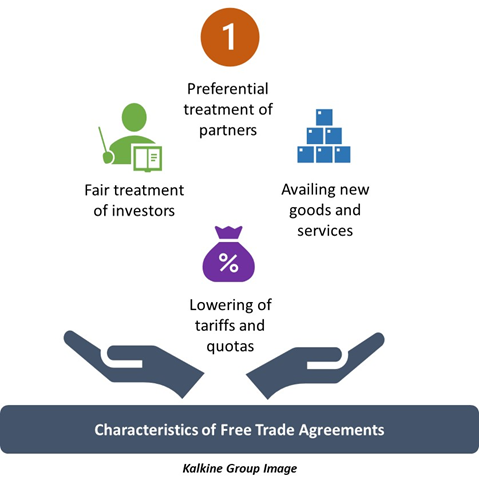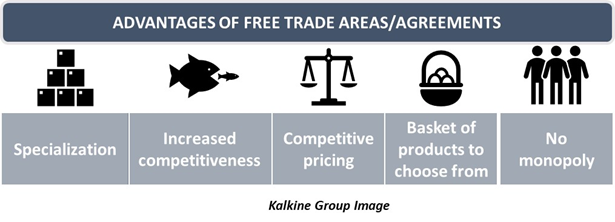Definition
Related Definitions
Free Trade Agreement
What is meant by a Free Trade Agreement?
A free trade agreement (FTA) is a trade deal between two or more countries wherein they agree upon certain trade-related rules and regulations that benefit them mutually. An FTA may include easing of certain restrictions that are otherwise maintained for the rest of the world. The region where countries have a free trade agreement with each other is known as free trade area.
The purpose of an FTA is to make trade between the participating countries easier and give preferential treatment to the participants in the agreement. Trade agreements of any kind go in line with the WTO’s policy of promoting free trade. They stand in stark contrast to protectionist trade policies like tariffs and quotas.
What types of Trade Agreements are there?
Trade agreements can be of the following types:
- UNILATERAL TRADE AGREEMENT: This involves a single country imposing restrictions and no other country reciprocating. It is also possible for a country to individually ease up on the restrictions placed on other countries; however, this would put the country at a competitive disadvantage.
In this type of agreement, if Country A in the Free Trade Area reduces the tariff on its imports, no other country in the Free Trade Area would reciprocate. This makes the agreement one-sided or unilateral.
- BILATERAL TRADE AGREEMENTS: This type of agreement involves two countries. It is a mutual agreement between two countries wherein they give each other preferential treatment.
An example of a bilateral free trade agreement is the Canada-United States Free Trade Agreement, this has been succeeded by the North American Free Trade Agreement (NAFTA). The agreement was made with the intention of forming a free trade area with conditions of fair competition, incentivised cross-country investment, and efficient resolution to trade-related disputes.
- MULTILATERAL TRADE AGREEMENTS: These involve more than two countries in the free trade area. These agreements may operate on a large scale and may include many countries that are willing to come to mutual terms about how to conduct trade.
An example of a multilateral free trade agreement would be the Regional Comprehensive Economic Partnership, which is the largest free trade agreement in the world. It includes 15 countries across the Asia-Pacific region.
What are the characteristics of a Free Trade Agreement?
A free trade agreement is beneficial because it involves the following characteristics for the countries participating in the agreement:
- Lowering of tariffs and quotas. For a country charging an ad-valorem import tariff, it may reduce the percentage of the participating countries to give them preferential treatment.
- FTAs may enable countries to sell to governments. Country A might be able to bid on government procurements in the partner country.
- There may be certain goods or services that are available in only one country. Free trade agreements may include trade of those of goods and services that were previously not a part of participant countries.
- Fair treatment of investors from either country. Partner countries would agree to give preferential treatment to each other’s investors.

Why are free trade areas important?
- Specialisation: Countries become specialised when they engage in imports and exports. With a basket of goods to choose from, countries need not produce all goods for domestic consumers. In an autarkic scenario, a country would have to produce all the goods and be self-sufficient. However, with free trade agreements in place, trade is facilitated across regions and countries can focus on the production of few goods which offer them a relative advantage.
- Increased competitiveness: When there are tariffs or quotas placed on the imports of certain goods, they become expensive. When imports are facilitated, there is an increased competition between domestic producers, which would then have to produce at a cheaper rate and perform more efficiently. Thus, imports help domestic firms hone their competencies.

- Competitive pricing: Free trade allows for prices to be lowered to international levels. This increases the purchasing power of consumers.
- Greater variety: There is a bigger basket of goods to choose from when imports are facilitated. A larger variety increases utility among consumers.
- No monopoly: When there are more sellers in the market, it becomes difficult for a monopoly to set in, thus averting the possibility of price differentiation in the market.
What are the disadvantages of a Free Trade Area?
- Lower tax revenue: Governments would not be able to earn tax revenue when quotas or tariffs are not implemented. However, to achieve the socially optimal level of production and prices in the economy, governments should encourage free trade agreements even though it would result in them losing out on tax revenue.
- Theft of intellectual property: International trade integration might enable certain countries to imitate the products and the production procedures followed by other countries. This can be done by reverse-engineering the products obtained from the trading partners. Thus, property rights might be at risk under free trade agreements.
